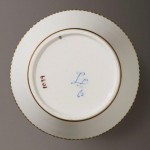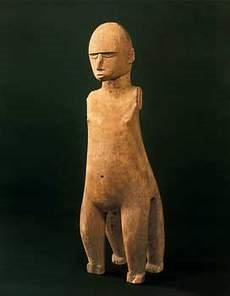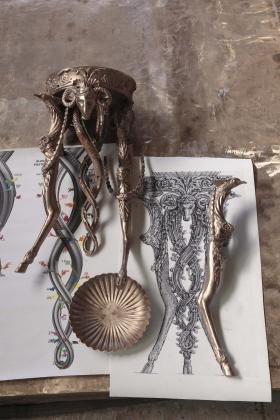Let’s talk positively (the news can be so negative). Among the riches at American museums at the moment, here are three innovative or unique ones I’d really like to see:
 Backstories: The Other Side of Art at the Clark Art Institute – Most museums visitors, I’d wager, don’t think much about what’s on the back of the art thery’re staring at. Too bad, as this exhibition demonstrates. The backs often show how or when something was made, whose collections they’ve belong to, or which galleries/auction houses have handled them, how they have been cared for and the changes they may have undergone. The Clark went into its permanent collection and found paintings, works on paper, sculpture, silver, and porcelain with interesting backsides, and is displaying them mostly on pedestals. They span five centuries and include works by Durer, van Gogh, Sevres porcelain made for Catherine the Great (verso, shown at right), Nolde, and Memling. When the exhibition was announced last December, Michael Conforti, the Clark’s director explained its origin:
Backstories: The Other Side of Art at the Clark Art Institute – Most museums visitors, I’d wager, don’t think much about what’s on the back of the art thery’re staring at. Too bad, as this exhibition demonstrates. The backs often show how or when something was made, whose collections they’ve belong to, or which galleries/auction houses have handled them, how they have been cared for and the changes they may have undergone. The Clark went into its permanent collection and found paintings, works on paper, sculpture, silver, and porcelain with interesting backsides, and is displaying them mostly on pedestals. They span five centuries and include works by Durer, van Gogh, Sevres porcelain made for Catherine the Great (verso, shown at right), Nolde, and Memling. When the exhibition was announced last December, Michael Conforti, the Clark’s director explained its origin:
The acquisition of a two-sided painting by Giovanni Battista Cremonini spurred our interest in the backs of other objects in our collection. As the curatorial team began to think about the objects in a different way, Backstories was born.
Kudos. If you, like me, can’t get to Williamstown before the show closes on Apr. 21, you’ll get a flavor of the show at the link above — it has several pages and examples and, very handily, a checklist.
 Objects of Belief from the Vatican: Art of Africa, Oceania, and the Americas at the deYoung Museum in San Francisco — At the Vatican Museums, many of us are too busy marveling at the ceiling of the Sistine Chapel and the Raphael rooms to get to the Ethnocological Museum there. This exhibition shows what a mistake that is. For the first time, the Vatican has sent 39 of its treasures, drawn from a collection that numbers more than 80,000 objects from indigenous cultures in Asia, Oceania, Africa, and the Americas, to the United States. Many are unique. According to the press release:
Objects of Belief from the Vatican: Art of Africa, Oceania, and the Americas at the deYoung Museum in San Francisco — At the Vatican Museums, many of us are too busy marveling at the ceiling of the Sistine Chapel and the Raphael rooms to get to the Ethnocological Museum there. This exhibition shows what a mistake that is. For the first time, the Vatican has sent 39 of its treasures, drawn from a collection that numbers more than 80,000 objects from indigenous cultures in Asia, Oceania, Africa, and the Americas, to the United States. Many are unique. According to the press release:
Highlights include two masks and three shrine carvings obtained in 1691 by Fray Francisco Romero in Colombia’s Sierra Nevada de Santa Marta; three figurative sculptures representing the gods Tu [one, at left] and Tupo sent by the first missionary in Mangareva to Pope Gregory XVI in 1837; and a 15th-century stone sculpture created in Mexico of the Aztec god Quetzalcoatl.
There are paintings on bark and stone from Australia, and on silk from China and Japan; wooden statues from Polynesia and stone ones from pre-Columbian civilizations; feather-works from Papa New Guinea and majolica from the Middle East. It remains on view until Sept. 8, while the Vatican museum is under renovation (reopening next year).
 Of course you know Piranesi well, why go to the San Diego Museum of Art, where Piranesi, Rome and the Arts of Design opened on Saturday? Because this Piranesi show is different. It begins with 300 original prints from the renowned collection of the Fondazione Giorgio Cini in Venice, and it goes on to offer modern-day interpretations using “new technologies such as video, photography, and digital modeling.” That means that a vase or teapot or fireplace, say, drawn by Piranesi, is present in the flesh, so to speak — in three dimensions. According to the museum:
Of course you know Piranesi well, why go to the San Diego Museum of Art, where Piranesi, Rome and the Arts of Design opened on Saturday? Because this Piranesi show is different. It begins with 300 original prints from the renowned collection of the Fondazione Giorgio Cini in Venice, and it goes on to offer modern-day interpretations using “new technologies such as video, photography, and digital modeling.” That means that a vase or teapot or fireplace, say, drawn by Piranesi, is present in the flesh, so to speak — in three dimensions. According to the museum:
These never-before-seen and never-before-crafted objects take center stage in the exhibition and attest to the creative intellect of Piranesi’s designs. In addition, the exhibition brings to life Piranesi’s most famous works, the Carceri (Prisons), in the form of a virtual reality 3-D installation.
Somewhere a 3-D printer must be involved. Already shown in Madrid and Barcelona, the exhibition has gotten rave reviews in Europe. It’s in San Diego until July 7.
Photo Credits: Courtesy of the Clark, the deYoung and the San Diego museums, top to bottom.
